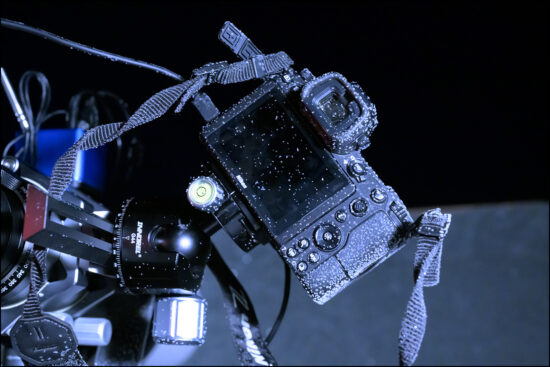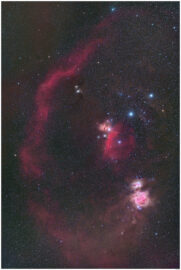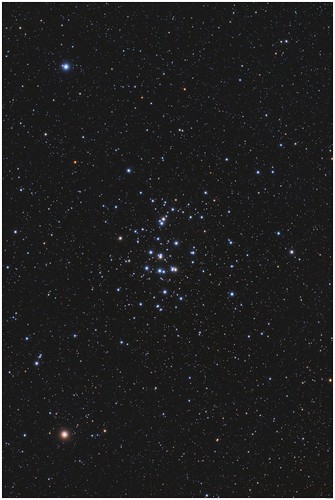
The Nikon NIKKOR Z 135mm f/1.8 S Plena lens ($2,496), an astrophotographer’s dream by Dominique Dierick:
Intro
I have been into astrophotography since 1975 and have probably imaged with hundreds of telescopes and different camera lenses over the years. Camera lens brands included Nikon, Canon, Fuji, Zeiss, Leica, Voigtlander, and Samyang. Telescopes usually have longer focal lengths, limiting the imaged area of the sky. If one wants to image larger structures, or bigger parts of the sky, camera lenses are the solution.
However, camera lenses are usually not very well optimized for astrophotography. Most lenses show chromatic aberration, lateral chromatic aberrations, astigmatism, and typical bird-in-flight-like coma on the stars. Even the top lenses do not escape from these problems. In my Canon days, the 200mm f/2.8 and the 135mm f/2 were reasonable ok lenses for astrophotography in the short tele range. Nikon had equally some decent lenses like the 105mm f/2.5 or the 180mm f/2.8ED.
All lenses had to be used stopped down to f/4 if you were critical about the form of the stars near the edges and corners of a full-frame camera. A few years ago, a new kid in town – Samyang (also sold under other brand names) released some lenses that were quite ok for astrophotography, notably the 135mm. It was not perfect but worked fine on APS format, and was not too critical on full frame. But you had to get a good sample. I have returned some Samyang lenses that were a victim of a decentered lens element.
From F to Z
After using Nikon DSLR cameras for many years, and the special edition D810a astro camera since its release, three years ago I gently made the switch to mirrorless cameras. I still kept the D810a for astrophotography, but in 2023 I bit the bullet and sold my loyal astro DSLR as the last souvenir of the Nikon F era. I replaced it with a Nikon Z6, which I had modified for astrophotography in the Netherlands by Dutch Digital Works. DDW removes the first IR blocking filter (or all filters for pure IR), to let the wavelength of Hydrogen Alpha pass to the sensor. This wavelength is one of the most important in astrophotography, but the IR blocking filter inside cameras (introduced to reproduce colors faithfully by blocking infrared) prevents imaging it. So it had to go. It’s not always easy to modify cameras this way, and still keep the sensor square with the bayonet. I had feared that with faster lenses, I would get a tilt of the image plane, but the modification was done perfectly.
After using the Z series for some time, I did notice that the current generation lenses offered better edge performance than their F counterparts. So, when Nikon announced the 135mm 1.8 Plena, I really wanted to try that extremely fast lens for astronomy. At first, I hoped to get one via NPS, but it wouldn’t be easy. Every photographer wanted to test it out when it was released, and planning its use would be difficult: one has to reserve upfront, and that is impossible because of the requirements for astrophotography: clear skies, no moonlight. Try to plan this in Belgium with our typical cloudy skies. So I bought my own sample. Worst case I would end up with a fast and excellent portrait lens (I had seen enough sample images made with the Plena). It turned out I was right about the weather, we had the worst fall and early winter in decades and had to wait till early January to get some clear skies.
The Nikon Z6 with the Plena is mounted on top of my telescope setup in the Belgian Ardennes. It rides parallel with the main telescope, tracking the stars. An early first try had shown a small problem. The Plena does not have a tripod bracket, so all the weight hung on the Z6 body, out of balance, and was prone to slight sagging because of gravity. This ever-so-slight sagging in the bayonet can already be responsible for not ideal corner performance. We are talking f/1.8 where microns are important.
Years ago I mounted my 180 ED lens on two points: one was the camera screw, the other a ring holding the front of the lens with three setscrews, an ideal solution:
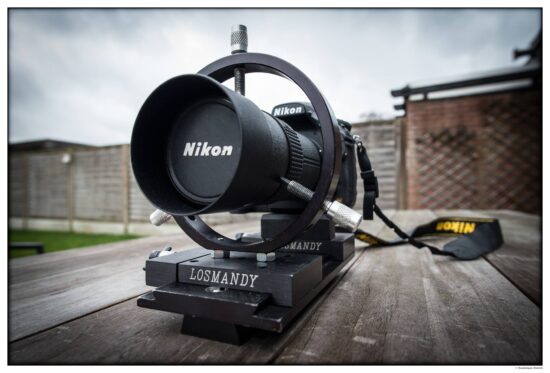
Unfortunately, I do not have this system anymore, so I looked for an alternative solution. I found a third-party tripod bracket for the Plena on the Web. It does not allow for lens rotation (the A/M switch prevents it), but it does give a stable and balanced workaround, putting less strain on the bayonet.
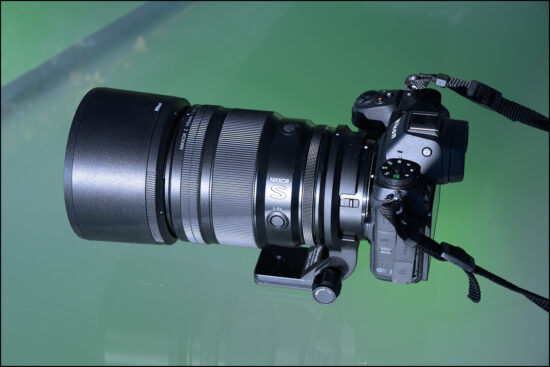
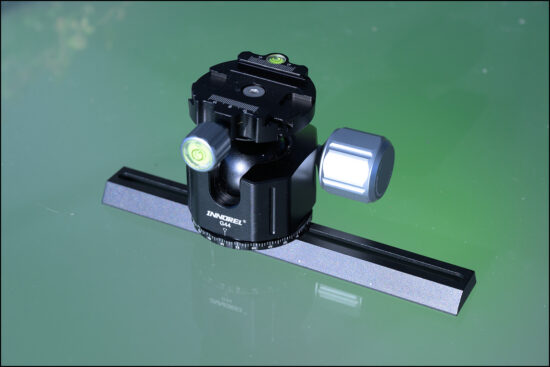
Since the camera can not rotate in the bracket easily, I just needed a stable ballhead to put it horizontally or vertically. I again found a good solution on the net: a low-profile, heavy-duty head which allowed me to put the camera horizontally or upright on top of the telescope. The tripod bracket of the Plena fits the Arca Swiss shoe of the ball head, which is bolted to a dovetail that fits a holder on top of the telescope system.
Results
I must say, I am impressed by the results I get from the Nikon Plena. Nikon had promised no coma, very low vignetting, sharp to the corners, and they delivered just that. The Plena is one of the best, if not the best lens I have ever used on a system or reflex camera for astrophotography. It wasn’t exactly cheap, but if you want perfection, the Plena is the closest thing to getting there. I would say it is 99 percent perfect.
The real test nights were brutally cold by Belgian standards. It got down to -12 degrees Celsius, and humid. The telescope, tracking mount, cables, and camera body were all covered with ice when I went to check the results in the morning. I feel lucky I have everything running on autopilot, so I don’t have to spend the night next to the cameras. A dew heater prevented the lens from fogging, and the lens was the only thing that stayed ice free… Actually, the XQD card would not come out of the Z6 until I had it warm up inside the house.
Before showing the processed results, here is a typical corner of the Plena wide open at f/1.8, cropped at full resolution. Notice how sharp and free of coma the stars are:
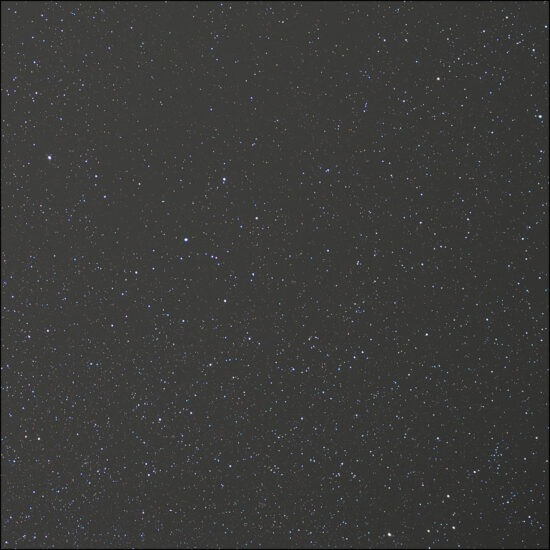
Compare this with an image with the 50mm 1.8 S lens at f/2.2, which – although excellent on its own – is no match for the Plena:
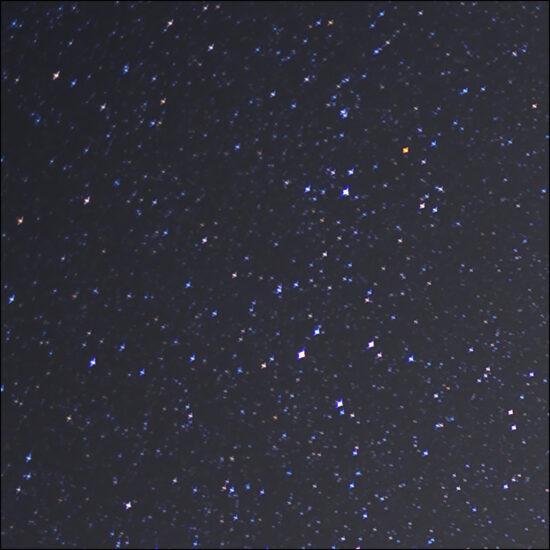
Astrophotography is a job of patience. Each image is made with tens or hundreds of individual frames, stacked together with stacking software to increase the signal-to-noise ratio. So are these samples.
At first, an area in Auriga, showing the Flaming Star Nebula in typical Hydrogen Alpha colors, but also a few open star clusters in our galaxy. It was exposed for 90 minutes (45 x 2 minutes at ISO 800). No calibration frames (dark frames, flat frames) were used. I corrected the light pollution (always present in Belgium) and color balance in Nikon NX Studio, then stacked all images using the AstroPixel Processor software, removed the remaining light pollution gradient in the sky using the same software, and finally enhanced contrast and colors in Adobe Photoshop CC:
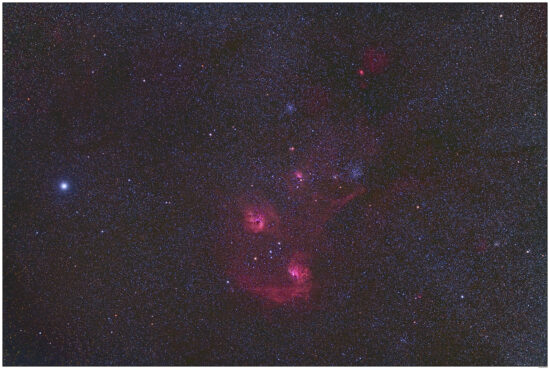
The second image is of the well-known constellation Orion. Or at least part of it. It shows the Horsehead Nebula, the Great Orion Nebula, and the enormous structure named Barnard’s Loop (after an American pioneer in astrophotography). Here the exposure was 210 minutes and the processing was done as the first image.
Conclusion
I couldn’t have been happier with the Plena for astrophotography. True, it is not an easy one to manage, as each little deviation in the camera-to-lens connection *will* show up, but well supported on a tracking mount, it is a fast and brilliant lens to capture the stars. Oh yes, and it does make might portraits as well any time of the day ;).
Larger versions of the images can be found in my Flickr album for 2024:
Dominique Dierick
If you have an interesting idea for a guest post, contact me here.
Sample photos taken with the new Nikkor Z 135mm f/1.8 S Plena lens on Nikon Z8 and Zf cameras
Plena vs. Art (Nikkor Z 135mm f/1.8 S Plena vs. Sigma 135mm f/1.8 DG HSM Art)
